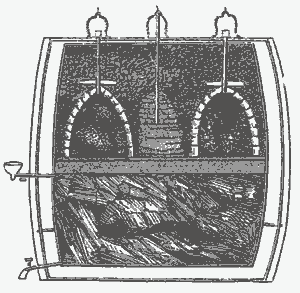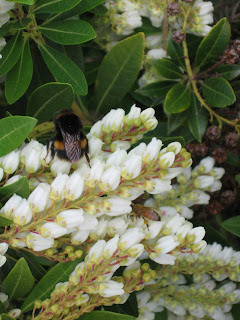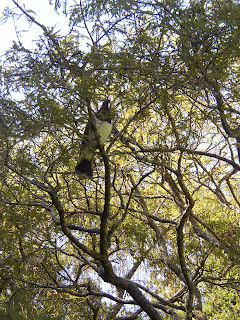Before New Zealand was settled by mainly the British, Scots and Irish in the early 1800`s,( my Meehan ancesters were very poor Irish potato farmers who came here, probably on the bottom of the sailing ship, in 1842,) there were no
Apis mellifera here, only different species of native solitary bees. Of course, as where ever they went in the world, the settlers brought their plants with them and expected them to grow ! In our temperate climate and great soils, they did - and how !! Alot became invasive and are now just a curse. Anyway, I digress, back to the bees.
The fruit trees and clover were not being pollinated by the native bees so the first honey bees were brought to NZ by the sister of a missionary, Mary Ann Bumby in March 1839 to a Weslyan Mission station in the Hokianga, which a beautiful area in the north of the North Is. The 2 skeps of bees were brought from Sydney Australia, having been introduced to the state of New South Wales in 1822 - no honey bees there either before the convicts !!
Anyway, there was this Reverend W C Cotton who also brought bees to our fair shores in 1842 from England by ship, this being the only quick way to get here in those days, in fact, the only way really. The good Reverend wrote a book called `My Bee Book` before he left, he starts with this written passage :

The Bee of England, like the Man of England, if he be but good of his kind, is, I think, surpassed by none in the world. I will not get bees from India - nor bees from South America - nor from New Holland, but carry them direct from England, sixteen thousand miles over the sea
Cotton then goes on to describe how he carried his bees across the oceans. Three colonies were placed in a barrel, which he had refurbished and recoppered, and the joints properly fitted. He lined the whole with thick felt. In the lower part of the barrel he packed with ice, with a tap to take off any melted water. The upper part of the barrel with the skep like hives was completely filled around the hives with well dried cinders thus excluding all light and heat. He wasn`t worried about air getting to the bees, but just in case he placed a small tube in each hive leading to the outside world and a tap at the bottom of the barrel to let out melted water. He reckoned that two thirds of the ice would 'cross the line' and a good half of the ice would have melted by the time they reached NZ.
He also tried an evaporation method as well as the ice. he suspended one hive on springs and another on gimbals so that the motion of the ship did not disturb them. He placed the hives in a double case with a wall of water surrounding them which is continously replenished by the ships system. The two cylinders of zinc in which the hives were placed were open at the top to allow evaporation to occur, a piece of rag was placed between the two cylinders so as to transfer water to the top of the hives thus ensuring an even surface over the hives to be cooled. Again he supplied a tube for air supply.
Finally , he made an observation hive which he feed with honey during the journey. We don`t know which plan worked the best as it wasn`t written in his book or the subsequent book ` A Guide for NZ Beekeepers` in 1848. We know at least some survived as the hard-working little honey bee is found through-out the country in the 21st century.
 My new grandson, Elliott Thomas was born last week - what a perfect Spring present - this little boy is surrounded by love, just like he should be - welcome to our wonderful world beautiful boy ..
My new grandson, Elliott Thomas was born last week - what a perfect Spring present - this little boy is surrounded by love, just like he should be - welcome to our wonderful world beautiful boy .. gathered there must be a nest close by. After some swift talking I managed to convince Cameron that he didn`t need to go looking for it so he could spray it to kingdom come ! I really like bumblebees, in fact I have a small tattoo ( horror, gasp etc) of a Bombus terrestis on my upper arm - where it can be covered if need be !!
gathered there must be a nest close by. After some swift talking I managed to convince Cameron that he didn`t need to go looking for it so he could spray it to kingdom come ! I really like bumblebees, in fact I have a small tattoo ( horror, gasp etc) of a Bombus terrestis on my upper arm - where it can be covered if need be !!  gathered there must be a nest close by. After some swift talking I managed to convince Cameron that he didn`t need to go looking for it so he could spray it to kingdom come ! I really like bumblebees, in fact I have a small tattoo ( horror, gasp etc) of a Bombus terrestis on my upper arm - where it can be covered if need be !!
gathered there must be a nest close by. After some swift talking I managed to convince Cameron that he didn`t need to go looking for it so he could spray it to kingdom come ! I really like bumblebees, in fact I have a small tattoo ( horror, gasp etc) of a Bombus terrestis on my upper arm - where it can be covered if need be !! 







 The Kowhai or (Sophora tetraptera) middle of the North Island and (Sophora microphylla) throughout NZ, are one of the best know early flowering native trees. Kowhai can reach a height of 12 metres, bursting into flower in the spring before the new leaves arrive. The bees compete with birds for the large amount of nectar produced form the gorgeous bright yellow bell-like flowers. The pollen is deep orange, but it is the nectar the bees tend to collect. The honey is a light amber in colour with a mild but distinctive flavour.
The Kowhai or (Sophora tetraptera) middle of the North Island and (Sophora microphylla) throughout NZ, are one of the best know early flowering native trees. Kowhai can reach a height of 12 metres, bursting into flower in the spring before the new leaves arrive. The bees compete with birds for the large amount of nectar produced form the gorgeous bright yellow bell-like flowers. The pollen is deep orange, but it is the nectar the bees tend to collect. The honey is a light amber in colour with a mild but distinctive flavour.



